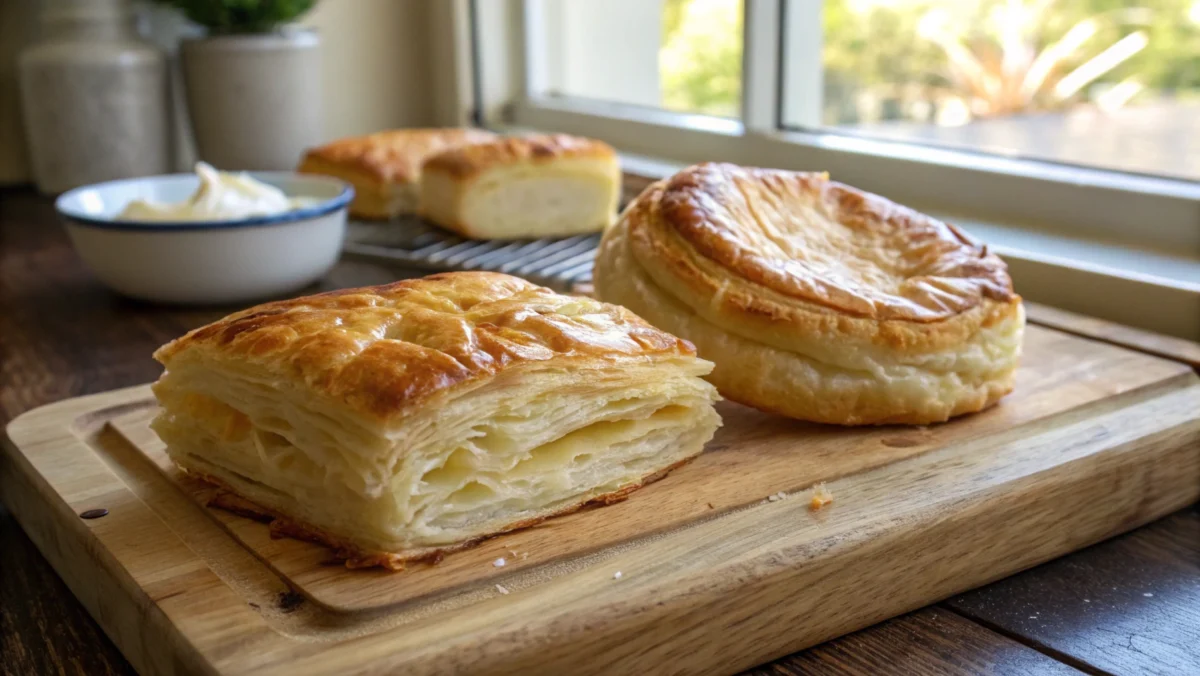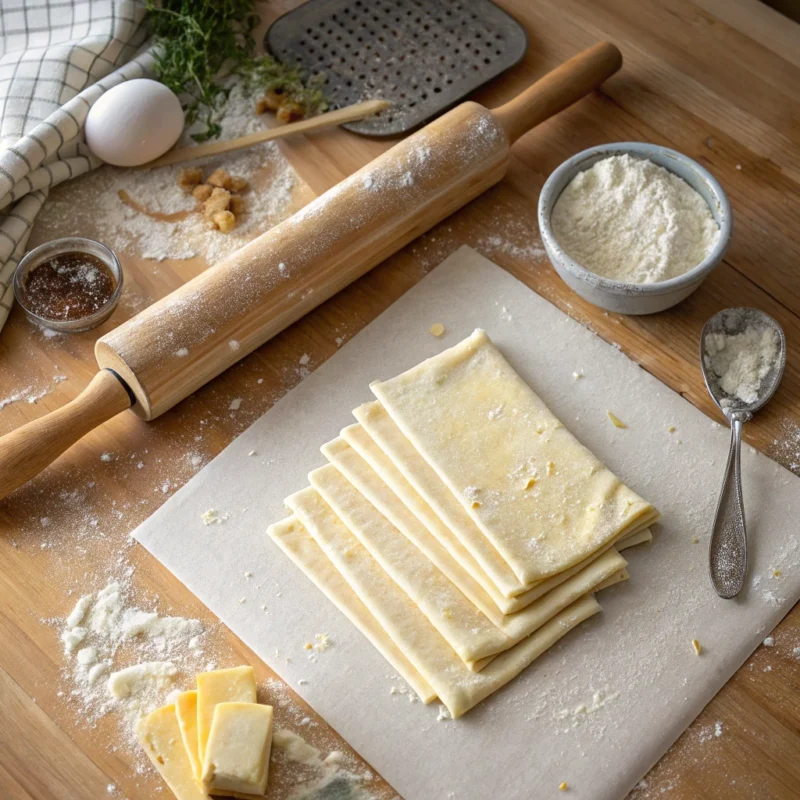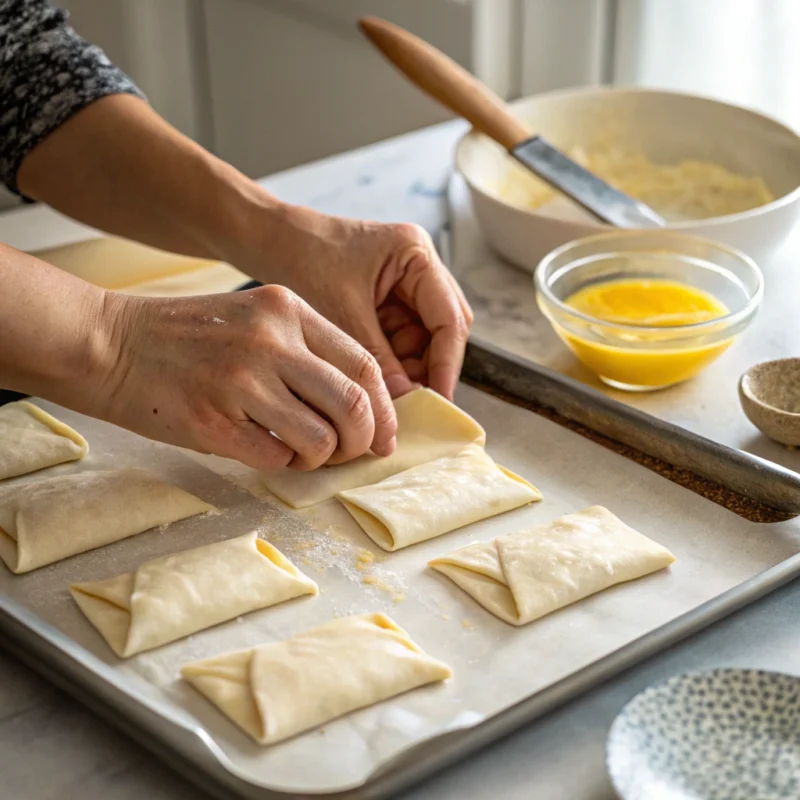
Introduction to Puff Pastry and Phyllo Dough
When you’re tackling recipes that call for flaky, buttery layers, the choice between different doughs can be confusing. A common question that arises is, “is Pepperidge Farm Puff Pastry the Same as Phyllo” Although they might look similar to the untrained eye, these two types of dough are not interchangeable. In this article, we’ll delve into the world of pastries, specifically comparing puff pastry, phyllo dough, and crescent dough. We’ll also explore when they can (and can’t) be swapped, how they’re made, and why Pepperidge Farm Puff Pastry often stands out.
Ready to unravel the layers of pastry confusion? Let’s start with an introduction to the main players: puff pastry and phyllo dough.
What Are Puff Pastry and Phyllo Dough?
Puff pastry is a light, flaky pastry dough made by layering dough and butter through a process called lamination. The butter creates steam when baked, causing the dough to puff into delicate, buttery layers. Famous for its versatility, puff pastry is often used in savory dishes like beef Wellington or sweet treats like turnovers.
Phyllo dough, on the other hand, is paper-thin and crisp. This pastry, a staple in Mediterranean and Middle Eastern cuisines, relies on oil or butter brushed between its layers to achieve its signature crackling texture. Think baklava or spanakopita. Unlike puff pastry, phyllo dough doesn’t puff up—it stays thin and crisp.
Overview of Pepperidge Farm Puff Pastry
Pepperidge Farm Puff Pastry is a popular pre-made version of puff pastry, available in the frozen aisle of most grocery stores. Known for its consistent quality and buttery flavor, it’s a go-to for both amateur and professional bakers. But one question that often arises is whether it’s interchangeable with phyllo dough or crescent dough. Spoiler alert: it’s not, and we’ll explain why later.
Importance of Understanding the Difference
Knowing the difference between puff pastry, phyllo dough, and crescent dough is essential for achieving the right texture and flavor in your dishes. Swapping one for another can lead to soggy layers or missed flakiness—not ideal when you’re aiming for culinary perfection!
Key Differences Between Puff Pastry and Phyllo Dough

Differences in Ingredients and Fat Content
One of the most significant differences between puff pastry and phyllo dough lies in their ingredients and fat content. Puff pastry is made using a process known as lamination, where dough and butter are repeatedly folded together. This creates multiple layers of dough and fat, giving the pastry its rich, buttery flavor and flaky texture. The butter not only adds flavor but also helps the dough puff up when baked due to the steam it creates.
On the other hand, phyllo dough contains very little fat. It is made with just flour, water, and a small amount of oil or butter, and it is stretched into ultra-thin sheets. This results in a much lighter, crispier texture. While phyllo dough may have a slight buttery taste if brushed with butter between layers, it is far less rich than puff pastry.
Preparation Techniques: Laminated vs. Stretched
The way each dough is made contributes to its unique texture and usage. Puff pastry requires a lengthy process of folding and rolling dough with butter. The dough is repeatedly chilled, then rolled out and folded to create hundreds of thin layers of dough and butter. This process is what gives puff pastry its characteristic layers and allows it to puff up when baked.
In contrast, phyllo dough is made by rolling out dough until it’s paper-thin. The dough is not layered with fat during the rolling process, so it doesn’t puff up in the same way. Instead, phyllo creates crispy, delicate layers when baked. Each sheet is often brushed with oil or butter before being stacked with others to create the desired texture.
Texture and Structure: Crispy vs. Buttery Layers
The most obvious difference between the two doughs is in their textures. Puff pastry is thick, buttery, and flaky, with multiple layers that puff up as it bakes, creating a soft, airy interior and a golden, crisp exterior. It’s perfect for dishes that need a rich, indulgent base, such as savory pies, tarts, or turnovers.
In contrast, phyllo dough is thin and crisp, never puffing up. Instead of a soft interior, phyllo remains crunchy, providing a delicate, crisp texture that holds up well in layered desserts like baklava or savory pastries like spanakopita.
The difference in texture means that while puff pastry is often used to create volume and a light, flaky bite, phyllo dough provides a more delicate, crispy crunch.
Flavor Profiles: Richness vs. Subtlety
Because puff pastry is made with butter, it has a rich, indulgent flavor that pairs perfectly with both sweet and savory dishes. The butteriness of the dough complements fillings like cheese, chocolate, and fruit, making it ideal for decadent desserts or savory pies.
Phyllo dough, on the other hand, is more neutral in flavor. Its simplicity allows the fillings—such as sweetened nuts or spinach and feta—to shine without the dough overwhelming them. The crispy texture of phyllo provides a contrast to moist or creamy fillings, creating a balanced bite.
Understanding these differences helps clarify why puff pastry and phyllo dough are often used in different culinary scenarios. While both are essential in the pastry world, knowing their unique characteristics allows you to choose the best option for your recipe.
Similarities and Occasional Interchangeability
When Can Puff Pastry and Phyllo Dough Be Substituted?
Although puff pastry and phyllo dough are distinct in texture and preparation, there are situations where one can stand in for the other. For example:
- Savory Pies and Tarts: Puff pastry adds a flaky, buttery crust, but phyllo dough can deliver a lighter, crispier finish. While they provide different textures, both can work depending on your preference.
- Layered Desserts: Phyllo dough’s thin, crispy layers can mimic the flakiness of puff pastry in some desserts, like strudels or mille-feuille, especially if you layer it with butter or oil.
That said, keep in mind that substitutions might slightly alter the final dish’s texture and flavor.
Culinary Scenarios Where Substitutions Work
If you’re in a pinch, here are some scenarios where you can substitute one dough for the other:
- Appetizers: Recipes like mini pies or turnovers can be adapted with either dough, though phyllo will be crispier while puff pastry will be richer.
- Light Desserts: For recipes like fruit tarts or baklava-inspired sweets, phyllo can replace puff pastry to give a delicate crunch.
Why They Aren’t Always Interchangeable
The biggest limitation when substituting phyllo dough for puff pastry (or vice versa) lies in their baking behavior. Puff pastry relies on the steam created by butter layers to rise and puff, while phyllo stays flat and crisp. For dishes that require height and flakiness—like croissants or vol-au-vents—puff pastry is irreplaceable.
On the other hand, phyllo’s thin, shattering layers make it ideal for recipes where crispness is the goal, such as savory pastries or delicate desserts like baklava. Trying to use puff pastry in these cases might result in overly thick or chewy results.
By understanding the strengths of each dough, you can choose the right one to elevate your recipe without compromising on texture or flavor.
Specifics About Pepperidge Farm Puff Pastry
Unique Features of Pepperidge Farm Puff Pastry
Pepperidge Farm Puff Pastry is renowned for its consistent quality and convenience. Made with a careful balance of flour, butter, and water, it offers a flaky texture that’s ideal for both sweet and savory recipes. Unlike phyllo dough, which is thin and paper-like, Pepperidge Farm Puff Pastry provides a buttery richness with distinct layers that puff up when baked.
This store-bought puff pastry is frozen, making it easy to store and use when needed. Just thaw it in the refrigerator for a few hours, and it’s ready to go. For bakers seeking consistent results without the hassle of making homemade puff pastry, this is a go-to option.
Common Recipes Using Pepperidge Farm Puff Pastry
Pepperidge Farm Puff Pastry shines in various dishes. From elegant hors d’oeuvres like cheese twists to comforting pot pies, its versatility is unmatched. Sweet tooth? Whip up classic apple turnovers or a rich mille-feuille.
If you’re curious about how to incorporate it into desserts, you might enjoy Easy Puff Pastry Dessert Recipes on Makouri Recipes. These ideas are perfect for elevating your culinary game without extra effort.
Comparison to Homemade Puff Pastry
The big question: is homemade puff pastry better? While nothing beats the flavor of freshly made puff pastry, Pepperidge Farm Puff Pastry offers a fantastic alternative. Homemade versions take hours of laminating and chilling, while the pre-made option is ready in a pinch.
Still, homemade puff pastry provides more control over the ingredients and can have a fresher taste. However, for most home cooks, the time-saving convenience of Pepperidge Farm Puff Pastry outweighs the effort required to make it from scratch.
For more puff pastry tips and tricks, check out recipes on Makouri Recipes. You’ll find inspiration to make the most out of this versatile ingredient.
Cooking Tips and Usage Scenarios
Best Practices for Handling Puff Pastry and Phyllo Dough

Working with Pepperidge Farm Puff Pastry or phyllo dough requires care to achieve the best results. Here are some essential tips:
- Thawing Correctly: Always thaw frozen puff pastry in the refrigerator. This keeps the butter layers intact, ensuring a flaky texture when baked. Phyllo dough, being thinner, should also be thawed in the fridge but handled gently to prevent tearing.
- Using the Right Surface: Lightly flour your work surface when rolling puff pastry. For phyllo, keep a damp cloth nearby to prevent the sheets from drying out.
- Chill Before Baking: After shaping puff pastry, chill it briefly to solidify the butter layers. This helps create a flaky rise during baking.
- Avoid Overloading with Fillings: Both types of dough are delicate—overfilling can cause sogginess or tearing.
Recommended Recipes for Puff Pastry vs. Phyllo Dough
Whether you’re using puff pastry or phyllo, choosing the right recipe matters:
- For Puff Pastry: Dishes like chicken pot pie, cheese twists, or fruit turnovers are crowd-pleasers. Pepperidge Farm Puff Pastry is perfect for recipes that rely on a buttery, airy crust.
- For Phyllo Dough: Try baklava, spanakopita, or layered desserts like galaktoboureko. These recipes benefit from phyllo’s crisp, crackling layers.
Curious to try new recipes? Visit Easy Puff Pastry Dessert Recipes for sweet inspiration.
Tips for Avoiding Common Mistakes
It’s easy to make small mistakes when working with puff pastry or phyllo. Here’s how to avoid them:
- Don’t Overwork the Dough: Excessive handling can make puff pastry lose its flakiness.
- Brush Butter Sparingly on Phyllo: Using too much butter between layers can make the dough greasy rather than crisp.
- Bake at the Right Temperature: Both puff pastry and phyllo need high heat to cook evenly and puff properly—typically around 375–400°F (190–200°C).
With these tips in mind, you’ll avoid soggy pastries and enjoy perfectly flaky, golden-brown results every time!
FAQs About Puff Pastry and Phyllo Dough
Can I Substitute Phyllo for Puff Pastry?
While you can substitute phyllo for puff pastry in some recipes, it’s not always ideal. The two doughs have very different textures and properties. Phyllo dough is thin and crisp, while puff pastry is rich, buttery, and flaky. For example, phyllo might work as a crust for a savory pie, but it won’t provide the airy, layered texture of puff pastry.
If you’re trying to decide between the two, consider the dish: recipes relying on flaky layers, like turnovers or vol-au-vents, are better suited for puff pastry. For crispy, delicate layers, phyllo is the way to go.
Is Puff Pastry the Same as Phyllo Pastry?
No, puff pastry and phyllo pastry are not the same. Puff pastry is made through a lamination process, where butter is folded into the dough repeatedly to create distinct layers. When baked, these layers puff up, giving the pastry its signature flaky texture.
Phyllo dough, in contrast, is paper-thin and doesn’t puff when baked. Instead, it creates a crispy texture when layered with butter or oil. This makes phyllo perfect for dishes like baklava, but not interchangeable with puff pastry for most recipes.
What’s Another Name for Puff Pastry?
Puff pastry is sometimes referred to as “pâte feuilletée,” its French name. You may also hear it called “flaky pastry” because of its signature airy layers.
In some regions, puff pastry is associated with specific dishes, like mille-feuille, leading people to refer to it by the dish rather than the pastry itself.
Where Do You Find Phyllo Dough in the Grocery Store?
Phyllo dough is typically found in the freezer section of the grocery store, near other frozen pastries and desserts. Look for it near puff pastry, pie crusts, or frozen doughs.
If you’re shopping for Pepperidge Farm Puff Pastry, it’s usually in the same area. Be sure to check the packaging carefully—phyllo and puff pastry are often side by side, and they can look similar at first glance.
These answers should clear up the confusion between phyllo dough and puff pastry, helping you choose the right option for your next recipe!
Conclusion
By now, you should have a clear understanding of the differences between puff pastry and phyllo dough, as well as their ideal uses in cooking and baking. While both types of pastry have their unique characteristics, they aren’t interchangeable in most recipes. From the buttery, flaky layers of puff pastry to the crisp, delicate sheets of phyllo, each offers something special for different culinary needs.
When choosing between the two, think about the texture and flavor you’re aiming for. Is Pepperidge Farm Puff Pastry the same as phyllo? Certainly not! But it stands out as a convenient and reliable option for achieving delicious, flaky results without the hassle of making pastry from scratch.
So whether you’re whipping up a batch of turnovers, baklava, or savory pot pies, you now have the know-how to pick the perfect pastry for the job. If you’re looking for inspiration, don’t forget to explore recipes like Easy Puff Pastry Dessert Recipes to elevate your cooking game.
Happy baking!
